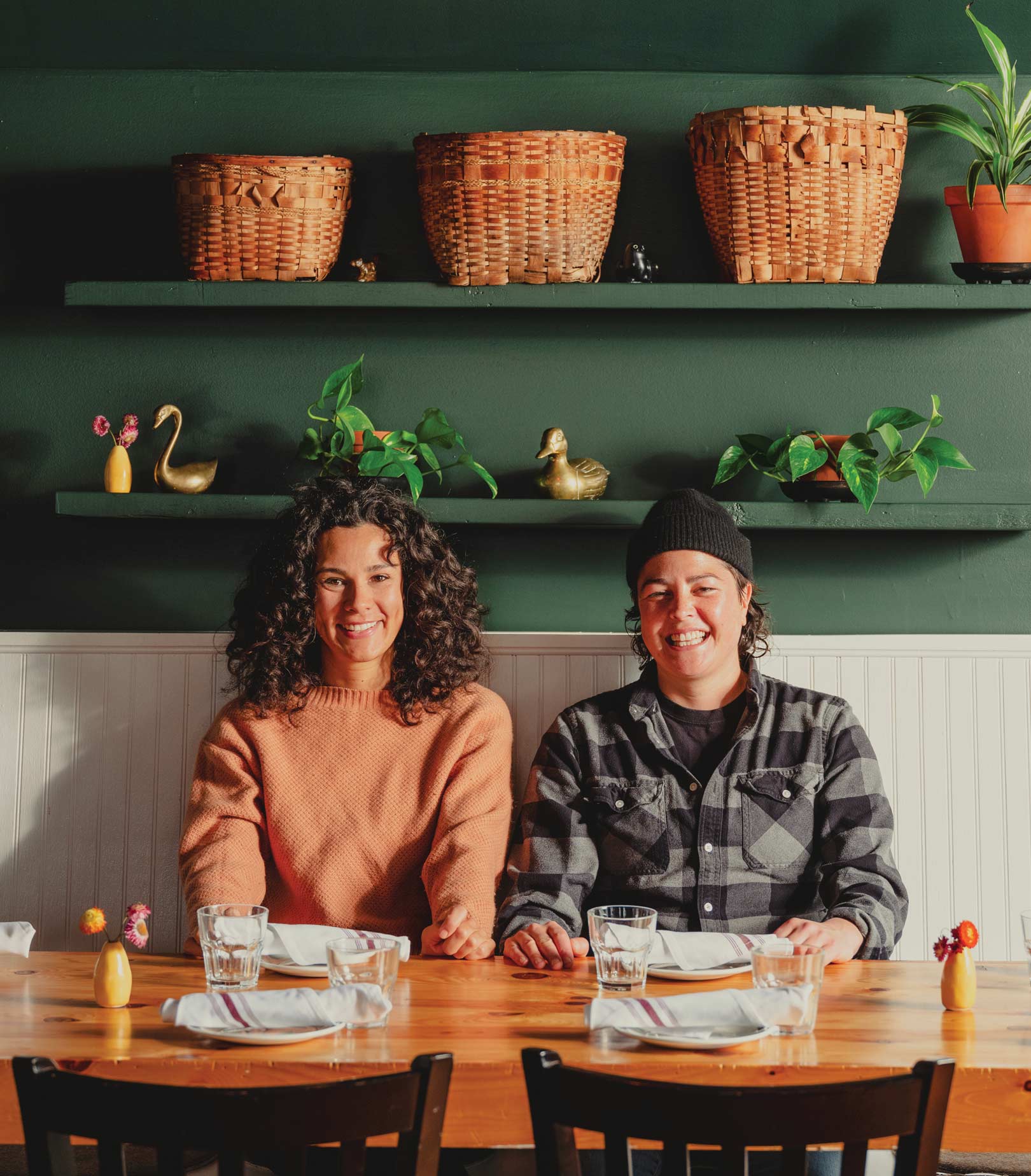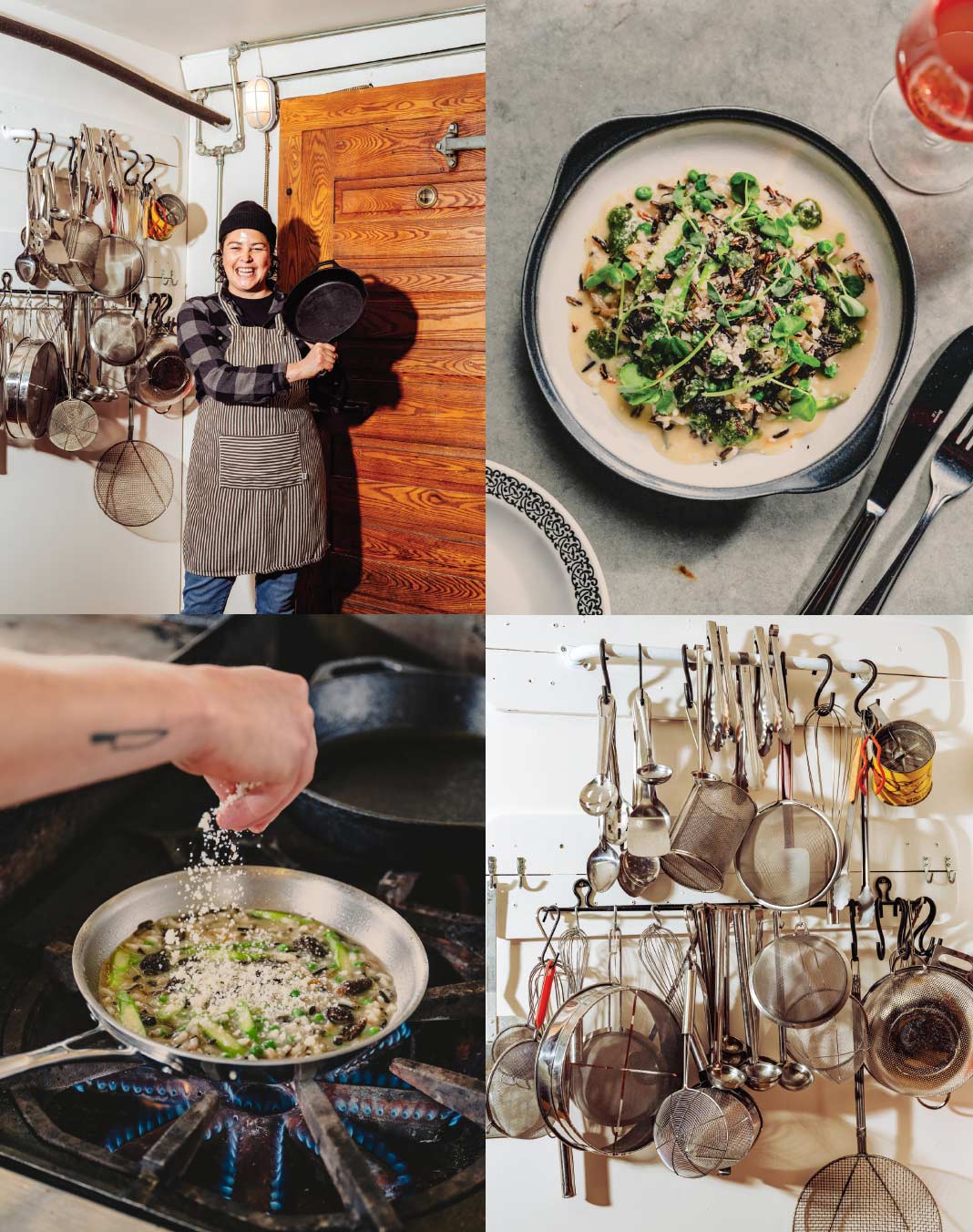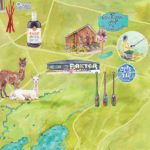


Left to Right: Shades of Gray Rabbitry, Keri Gray and Brian Chaney; Long Dog Vineyard & Winery, Steven Rapkin, James Lahti and Victoria Rose; Waupoos Highbush Blueberries, Maria and Gil Melo;
Yes, there really is a Stella, and she’s a force still running strong through Chef Leah Marshall Hannon.
At Stella’s Eatery in Waupoos, Prince Edward County, Leah Marshall Hannon honours the legacy of grandmothers, mothers, and her outdoorsman father. In the Ojibwe culture, the moon is thought of as a grandmother; Leah’s restaurant celebrates her grandmother’s tradition while her menus reflect her Indigenous roots.
Stella Pamajewon Marshall, Chef Leah’s nokomis, or grandmother, raised her family on the shores of Pickerel River near Parry Sound, a community on Georgian Bay. Stella held the wisdom and techniques that had been handed down to her from her ancestors and created comfort through food. And although Leah never had the chance to meet her grandmother, the stories and memories of family meals were treasured heirlooms and made a lasting impression on her.
“I was born in Parry Sound,” says Leah. “But when I was two, my parents split and I moved to Toronto with my mom. My dad, Ray, stayed in Parry Sound, so I went back and forth a lot.” The combination of urban and rural experiences have proven foundational to the chef she would become.
Leah’s mom, Sheila, was a wonderful cook. “My mom worked in catering, restaurants, and bars. She had her own catering business. I guess that’s where I inherited the aspiration of owning my own restaurant.”
Her mother also worked in social services and women’s shelters in Toronto until they moved back to Parry Sound. Perhaps this is how Leah developed her keen sense of community and giving back.
She also grew up foraging and hiking with her dad. “It was something we loved to do together. He would teach me about edible plants and how to make a good fire. He knew everything out there that was good to eat and when we went for our long hikes, he pointed it all out to me. He loves to cook over an open fire.”
She developed a love of food, nature, and her confidence from both her parents, and on reflection she adds, “My parents always believed in me.”
Leah did a year at George Brown College, but left for on-the-job experience; she would spend the next 10 years cooking in some of the best kitchens in Toronto and later in the County. “I did most of my learning working for some really great chefs,” says Leah. “In Toronto for Chef Corinna Mozo; at Czehoski; at Mid Field Wine Bar; and in the County, at Sand and Pearl.”
Now, with her dream of restaurant ownership realized, Leah – along with life and business partner, Cristina Meillon – is bringing it all together deliciously and ethically. Keeping things simple and tasty, she prepares comfort food inspired by the fresh and seasonal ingredients sourced from local farmers and suppliers. The chalkboard menu changes daily, depending on the availability of foraged, farmed, and seasonal ingredients. “It’s more work,” says Leah. “But it’s more exciting, and when you’re working with local producers, you have to be able to act fast. A farmer can walk in at seven on a Friday night with a box of something and we need to be able to put it on the menu the next day!”
The same is true of the bar, with Cristina’s seasonal cocktails featuring house-made syrups, infusions, garnishes and foraged goodies such as sumac and spruce tips.
“We appreciate our community, farmers and suppliers,” says Leah. “We strive to continuously learn and discover more about the bounty nature has to offer, and we aim to support female entrepreneurs, business owners, winemakers, farmers, and community members as much as possible.”
The restaurant sits on one acre with two mature maples they tap to make syrup. There’s a beehive, and the couple are putting in vegetable and herb gardens. “We are very sustainable-minded,” says Leah. “I still go foraging. In the spring I find morels, and I go back up north to forage with my dad for wild leeks – only harvesting a few from the middle of the patch.”
The kitchen sends out only sharing plates. “There are no appetizers, no mains, it’s all for sharing,” says Leah. “That was a bit hard for some customers to understand. Some people don’t like to share, but we think it’s just a more communal way to eat.”
This is the second iteration of Stella’s. Leah opened the first, much smaller, Stella’s in 2018 in downtown Picton. She expanded to this larger spot – 60 seats inside, 50 on the patio – in 2021. With help from friends and family, she and Cristina did the upgrades and renos, from a new cistern to new wiring, even digging out decommissioned underground fuel tanks left behind by a former gas station.
The place is calm, pretty and a little rustic in shades of deep forest green and soft cream, with warm, worn wood floors; it’s a colour palette that could be inspired by the menu. The mix-and-match furnishing – from church pews to sleek Mid-century modern – came about, as Leah jokes, “…by hitting Kijiji hard!” And from the road, the cheerful pink doors – a Stella’s trademark – glow like a beacon, inviting the traveller to pull in to this place that has had many lives: convenience store, butcher shop, pool hall, mustard maker, gas station and pub. “People still come in looking for pub grub,” says Leah. “So, we decided to give it to them once a week. Why not?” Indeed, the couple is very giving. “We’ve done fundraising for Thunder Woman Healing Lodge Society, Red Cedars Shelter, Indspire, Alternatives for Women, and LGBTQ causes,” she says. “But basically, Stella’s is a place where you can come to eat good comfort food and enjoy a nice drink.”
Spring Wild Rice Risotto
Wild rice risotto is the one dish on our menu year ’round. It’s not only delicious and a crowd pleaser, but it’s so versatile. Change some of the flavours and garnishes with the seasons and it becomes an annual staple.
Ingredients
For the Pesto
¼ cup coarsely chopped fresh basil leaves
1 cup fresh spinach, arugula, or garlic mustard greens
¼ cup sunflower seeds or pumpkin seeds, lightly toasted in a dry pan for a nuttier flavour; plus more for garnishing
1 clove garlic
1 tsp. maple syrup
1 tsp. sea salt
½ cup organic sunflower oil
For the Arborio Rice
1 tbsp. unsalted butter or organic sunflower oil
2 cloves garlic finely minced
1 shallot, very finely chopped
½ cup arborio rice
½ cup dry white wine
4 cups hot vegetable or mushroom stock
¼ tsp. sea salt or more to taste
For the Wild Rice
1 cup wild rice
3 cups water
½ tsp. sea salt or more to taste
For the Garnishes
2 cups of your favourite fresh, local, seasonal spring vegetables. We used fresh green peas, asparagus, and morels, but spinach, pea shoots, garlic mustard, arugula, garlic scapes, sugar snap peas, wild leeks – ethically sourced or foraged! – or shaved radish work wonderfully too. Cook some, and save some for a final raw garnish as desired.
½ cup shaved local hard cheese such as Manchego, mixed with Parmigiano or pecorino; plus extra for the table.
5 tbsp. unsalted butter; divided
Directions
- First, make the pesto and set aside; this can be made up to three days ahead and kept in the fridge. Add the first six ingredients to the bowl of a food processor and blend to a paste. Add oil and blend until creamy.
- To make the arborio rice, into a saucepan over medium heat, add butter or oil; once melted add garlic and shallot and cook, stirring often until translucent – about 5 minutes.
- Add rice and reduce heat to medium low; stir for 5 minutes continuously to release the starch and toast but not brown the rice. Once the rice is translucent around the edges, add wine and reduce to low heat; continuously stir until wine has evaporated.
- When wine has evaporated begin adding the hot stock in cup by cup. Keep the stock in a small saucepan over low heat. Stir continuously – every 30 seconds – while simmering until stock is evaporated, and continue the process until rice is creamy and al dente. Stir in salt. Set aside. This part can also be made a day or two in advance if kept covered in the fridge.
- To make the wild rice: add all ingredients to a medium saucepan over high heat; bring to a boil then reduce heat to low. Stir once, cover and allow to simmer for 45 minutes. Stir once or twice and if any liquid remains when rice is tender, drain. Wild rice can be made a day or two ahead and kept covered in the fridge.
- Slice or chop vegetables into smallish pieces; whatever your heart desires. Set aside.
To Bring it all Together
- Into a medium skillet or saucepan over medium heat, add 3 tablespoons butter and cook until it begins to brown and starts to smell nutty. As soon as butter begins to brown, add vegetables and a pinch of salt and continue to cook, stirring gently for 30 seconds.
- Add equal parts cooked arborio and wild rice; add more stock to cover the rice and vegetables and bring to a gentle boil.
- Add 2 tablespoons of butter once boiling and reducing. Once everything has thickened to a creamy consistency add 1/2 cup of the cheese; blend and stir until cheese is melted.
- Transfer to 4 serving plates or one platter and garnish with fresh microgreens, shaved raw radish, more cheese, a few seeds, and a generous drizzle of pesto.
Makes 4 servings.
Shades of Gray Rabbitry
Keri Gray and Brian Chaney
“Shades of Gray Rabbitry is an Indigenous-owned, family-run business,” says Chef Leah. “We love their beautiful fresh rabbits and quail eggs. Rabbit is a delicious, nutritious, and sustainable meat that’s extremely versatile; we fry, braise, and make it into confit and rillettes; it’s in a sugo (sauce) for our handmade pasta, and we use it instead of beef in the picadillo for our bannock taco.”
The farm is an Algonquin of Pikwakanagan First Nation business, certified by the Canadian Council for Aboriginal Business, that takes pride in producing healthy and ethically raised meats and other produce, using eco-friendly and sustainable practices, designed to care for the land for future generations, while producing a wonderful, natural product. Co-owners Keri Gray and Brian Chaney became interested in rabbit meat as a hypoallergenic option for their daughters, who suffered from food allergies. Health – human and rabbit – is always top of mind. The farm’s team includes a local veterinarian, and a Guelph University rabbit specialist, ensuring healthy, natural, and enriched environments for the rabbits. Shades of Gray also supply local grocery and butcher shops.
shadesofgrayrabbitry.ca
Long Dog Vineyard & Winery
Steven Rapkin, James Lahti and Victoria Rose
Victoria Rose and James Lahti took that first step on the slippery slope of becoming vintners in 1997 when at the urging of friend, Steven Rapkin, they purchased a County property in Milford that was meant to be a country escape from their hectic Toronto lives in the film industry. But by 1999 they had started planting vines, and by 2004, their first bottles were on the market.
The trio craft their wines with 100 percent organically grown grapes from their own vineyard, picked and sorted by hand, and processed onsite. Their Pinot Gris and Chardonnays have a hint of hue, having been left on the skins for 24 hours, then pressed.
Stella’s co-owner, Cristina Meillon, pours Pinot Noir, Chardonnay and Sparkling Gamay. “They specialize in what our terroir is known for,” says Cristina, “and have come to be super consistent with the flavours and quality of the wines they produce from this very special, kind of wild, and extremely picturesque vineyard. The wines are instant hits with guests.” Long Dog wines are not available at the LCBO, so tasting them calls for a trip to the County.
Waupoos Highbush Blueberries
Maria and Gil Melo
When Maria and Gil Melo retired in 2015, they purchased a property, just north of Waupoos. “It was a waterview property,” says Maria. “But we were really looking for waterfront at the time.” In 2019, when the Little family – who 40 years earlier established the first blueberry patch in the County – put their waterfront lot on the market, it included one and a half acres of blueberries and most importantly, a waterfront. “We already had a property just up the hill from there,” recalls Maria. “So we thought we would try our hand at preserving the blueberry patch, which the Littles had always grown pesticide-free.”
The first two years were challenging, but the Littles were generous with their knowledge and the patch survived, and here they are: Season Four. “We approached Stella’s two years ago when we had our first bumper crop of berries,” says Maria. “Leah and Cristina are great.” The appreciation is mutual. “Their berries,” says Chef Leah, “are delicious, plump, and pesticide-free. We use them in desserts, barbeque sauces, cocktails, preserves and compotes. During harvest season, we stock up and preserve what we can.”
Facebook: Waupoos-U-Pick-Highbush-Blueberries
Story by:
Signe Langford
Photography by:
Johnny C.Y. Lam




